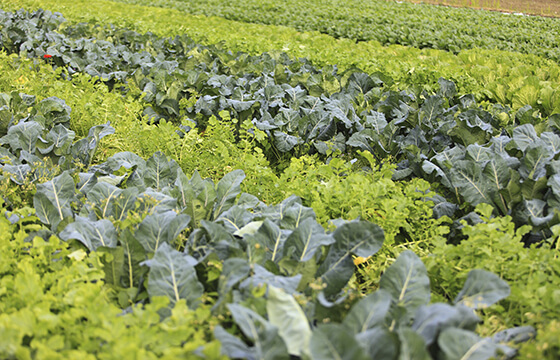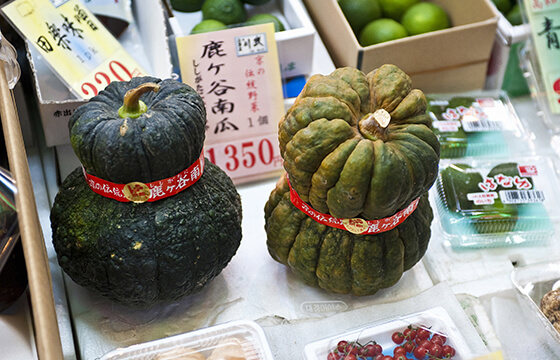
Vegetables in Kyoto

As expressed in its name "three mountains and three rivers," Kyoto is surrounded by Higashi Yama (literally, East Mountain), Kita Yama (North Mountain), and Nishi Yama (West Mountain) on three sides, with Takano, Kamo and Katsuura Rivers running through it.
These features made it an ideal geographical location for a castle town explaining why these rich plains had been the capital for over 1000 years.
People and goods gather in cities.
Where there is people, there is food.
As cultures develop, the culinary culture develops as well.
It is an understatement to say that cooking in Japan has developed from Kyoto with its long history as a capital.
Until the development of the distribution system, Kyoto was not all that rich in ingredients, as it had no easy access to fresh fish.
Actually, dishes that were used for imperial events became known as yushoku ryori.
Even then, the glamorous menu that we now know used salted, preserved or dried fish.
In order to diversify their menus, cooks were forced to experiment with various cooking methods.
As a result, Kyoto cooking developed a distinctive taste.
Furthermore, to replace the lack of quality ingredients, numerous vegetables were made part of their cooking.
Hence the beginning of Heiankyo (Kyoto as the capital of Japan) was the start of the history of Kyoto vegetables.
The types of vegetables grown was influenced by the different cooking styles found in Kyoto.
By the Edo period, party dishes known as honzen ryori had developed.
These had their roots in the gishiki ryori (ceremonial cooking) of the nobles.
This type of cooking also led to kaiseki ryori, which originated in the latter half of the 15th century together with the tea ceremony.
This type of cooking focuses on the taste of the food and the seasonal ingredients.
In turn, this led to farmers experimenting with growing different vegetables.
In Kyoto, where there are many temples, there is shojin ryori, which is a type of vegetarian cooking eaten by Buddhist priests as part of their pursuit of enlightenment.
This distinct style of cooking primarily uses beans and vegetables and does not use meat, fish or eggs.
Shojin ryori spread to ordinary citizens resulting in obanzai.
Then, to meet the palates of aristocrats, tea masters, priests and lay people, various kyo yasai were harvested.
These vegetables were cooked or stewed and continues to fill the stomachs of Japanese.
Obanzai’s second name is "omawari.
" Kyoto has festivals and events all year long, and has a tradition of eating specific foods on specific days.
On the first day of the month, kombumaki (fish rolled in kelp cooked in broth) is eaten, while on days with the number eight, arame (brown algae simmered with fried tofu) is eaten.
At the end of the month, the food of choice is Okara (bean curd by product cooked with vegetables) and on the fifteenth of the month, cooked potato.
Generally, food eaten by the masses in Kyoto is said to be very simple.
In actuality, it is a combination of well balanced dishes that includes dried and preserved food, soy beans and other fatty ingredients to be cooked together with vegetables.
It is always a tradition to have two to three kinds of small side dishes, balancing the taste and as a basis for good nutrition.
Obanzai was a result of good kyo yasai, and kyo yasai was a good result of obanzai.
These features made it an ideal geographical location for a castle town explaining why these rich plains had been the capital for over 1000 years.
People and goods gather in cities.
Where there is people, there is food.
As cultures develop, the culinary culture develops as well.
It is an understatement to say that cooking in Japan has developed from Kyoto with its long history as a capital.
Until the development of the distribution system, Kyoto was not all that rich in ingredients, as it had no easy access to fresh fish.
Actually, dishes that were used for imperial events became known as yushoku ryori.
Even then, the glamorous menu that we now know used salted, preserved or dried fish.
In order to diversify their menus, cooks were forced to experiment with various cooking methods.
As a result, Kyoto cooking developed a distinctive taste.
Furthermore, to replace the lack of quality ingredients, numerous vegetables were made part of their cooking.
Hence the beginning of Heiankyo (Kyoto as the capital of Japan) was the start of the history of Kyoto vegetables.
The types of vegetables grown was influenced by the different cooking styles found in Kyoto.
By the Edo period, party dishes known as honzen ryori had developed.
These had their roots in the gishiki ryori (ceremonial cooking) of the nobles.
This type of cooking also led to kaiseki ryori, which originated in the latter half of the 15th century together with the tea ceremony.
This type of cooking focuses on the taste of the food and the seasonal ingredients.
In turn, this led to farmers experimenting with growing different vegetables.
In Kyoto, where there are many temples, there is shojin ryori, which is a type of vegetarian cooking eaten by Buddhist priests as part of their pursuit of enlightenment.
This distinct style of cooking primarily uses beans and vegetables and does not use meat, fish or eggs.
Shojin ryori spread to ordinary citizens resulting in obanzai.
Then, to meet the palates of aristocrats, tea masters, priests and lay people, various kyo yasai were harvested.
These vegetables were cooked or stewed and continues to fill the stomachs of Japanese.
Obanzai’s second name is "omawari.
" Kyoto has festivals and events all year long, and has a tradition of eating specific foods on specific days.
On the first day of the month, kombumaki (fish rolled in kelp cooked in broth) is eaten, while on days with the number eight, arame (brown algae simmered with fried tofu) is eaten.
At the end of the month, the food of choice is Okara (bean curd by product cooked with vegetables) and on the fifteenth of the month, cooked potato.
Generally, food eaten by the masses in Kyoto is said to be very simple.
In actuality, it is a combination of well balanced dishes that includes dried and preserved food, soy beans and other fatty ingredients to be cooked together with vegetables.
It is always a tradition to have two to three kinds of small side dishes, balancing the taste and as a basis for good nutrition.
Obanzai was a result of good kyo yasai, and kyo yasai was a good result of obanzai.
TM © Rugby World Cup Limited 2015. All rights reserved.
)
)